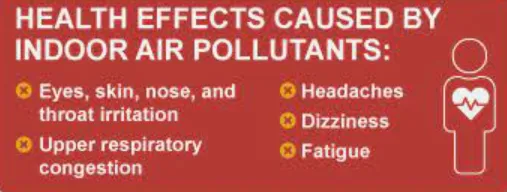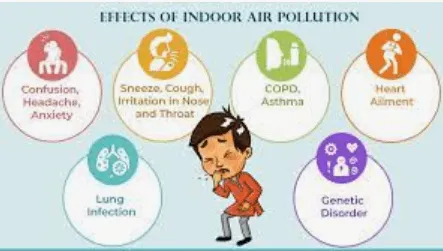WISE DUAL POINT IONIZATION
When was the last time you checked or investigated your building’s Indoor Air Quality (IAQ)?
Dual Point Ionization technology helps clean indoor air without producing harmful levels of ozone or other byproducts. All Needlepoint Bi-Polar Ionization (NPBI™) products are UL 2998 certified. Through NPBI, our product helps improve the air by reducing airborne particles including certain odors, viruses, and bacteria.
ONE OF THE LARGEST CARBON FOOTPRINTS ON THE PLANET
Indoor Air Pollution and Health
Indoor Air Quality (IAQ) refers to the air quality within and around buildings and structures, especially as it relates to the health and comfort of building occupants. Understanding and controlling common pollutants indoors can help reduce your risk of indoor health concerns.
Health effects from indoor air pollutants may be experienced soon after exposure or possibly years later.
THE SMART WAY TO REDUCE A CARBON FOOTPRINT
Primary Causes of Indoor Air Problems
Indoor pollution sources that release gases or particles into the air are the primary cause of indoor air quality problems. Inadequate ventilation can increase indoor pollutant levels by not bringing in enough outdoor air to dilute emissions from indoor sources and by not carrying indoor air pollutants out of the area. High temperature and humidity levels can also increase concentrations of some pollutants.
There are many sources of indoor air pollution. These can include:
Fuel-burning combustion appliances
Tobacco products
Building materials and furnishings
Deteriorated asbestos-containing insulation
Newly installed flooring, upholstery, or carpet
Cabinetry or furniture made of certain pressed wood products
Products for cleaning and maintenance
Central heating and cooling systems and humidification devices
Excess moisture
Outdoor sources such as:
Radon
Pesticides
Outdoor Air Pollution
The relative importance of any single source depends on how much of a given pollutant it emits and how hazardous those emissions are. In some cases, factors such as how old the source is and whether it is properly maintained are significant. For example, an improperly adjusted gas stove can emit significantly more carbon monoxide than one that is properly adjusted.
Immediate Effects
Some health effects may show up shortly after a single exposure or repeated exposures to a pollutant. These include irritation of the eyes, nose, and throat, headaches, dizziness, and fatigue. Such immediate effects are usually short-term and treatable. Sometimes the treatment is simply eliminating the person's exposure to the source of the pollution, if it can be identified. Soon after exposure to some indoor air pollutants, symptoms of some diseases such as asthma may show up, be aggravated or worsened.
The likelihood of immediate reactions to indoor air pollutants depends on several factors including age and preexisting medical conditions. In some cases, whether a person reacts to a pollutant depends on individual sensitivity, which varies tremendously from person to person. Some people can become sensitized to biological or chemical pollutants after repeated or high-level exposures.

Long-Term Effects
Other health effects may show up either years after exposure has occurred or only after long or repeated periods of exposure. These effects, which include some respiratory diseases, heart disease and cancer, can be severely debilitating or fatal. It is prudent to try to improve the indoor air quality in your building even if symptoms are not noticeable.
While pollutants commonly found in indoor air can cause many harmful effects, there is considerable uncertainty about what concentrations or periods of exposure are necessary to produce specific health problems. People also react very differently to exposure to indoor air pollutants. Further research is needed to better understand which health effects occur after exposure to the average pollutant concentrations found in businesses and which occurs from the higher concentrations that occur for short periods of time.

FAQs: DUAL POINT IONOZATION
I can see how this product cleans the air but how does it save energy?
Outdoor air is required to ventilate a property according to the Ventilation Rate Procedure, which requires HVAC equipment and HP. Improving the indoor air quality and minimizing contaminants, a site may be able to substantially reduce the need to bring in outdoor air, which could save on HVAC equipment costs and reduce energy consumption. (Reference: Indoor Air Quality Procedure IAQP in ASHRAE 62.1)
Does the product keep my HVAC ducts clean, eliminating the need for annual or periodic cleaning?
Customers who have installed Dual Point Technology have greatly reduced or eliminated the need for duct cleaning.
CREATING A SAFER WORKPLACE
Dual Point Ionization:
Creating a Safer Work Space for your Employees and Customers
Our Dual Point Ionization with patented NPBI technology helps reduce particles in the air by introducing ions into space via the airflow in your ventilation system. When these ions disperse throughout a space, they seek out and form bonds with particles in the air through a process called agglomeration. This creates a snowball effect in which particles begin to cluster together. The larger a cluster of particles becomes, the easier it is for your system to filter it out of the air. In addition to this clustering effect, contact with ions also inactivates certain viruses and bacteria.
IT TARGETS PARTICLES - When ions introduced by NPBI disperse throughout a space, such as an office or a schoolroom, they combine with particles suspended in the air. This creates a snowball effect in which particles of opposite polarities begin to cluster together, making them easier to capture in your filtration systems.
IT TACKLES ODORS - NPBI reduces odor-causing volatile organic compounds (VOCs) and leaves indoor air smelling fresher.
IT REQUIRES NO ONGOING MAINTENANCE - Dual Point Ionization auto-cleaning air ionization systems ensure optimal long-term performance because no replacement parts or ongoing maintenance is required
Dual Point Ionization does all this and adds NO HARMFUL BYPRODUCTS.
Our product complies with UL 2998 “Zero Ozone” Certification.
This certification meets the UL qualification standard for ozone-free emissions and is compliant with the American Society of Heating, Refrigerating and Air-Conditioning Engineers (ASHRAE) guidance.
NOTE: Please mark this call in your calendar before you show up (you will get a reminder as soon as you complete the form)
©2022 - Pack A Drum
Contact
Company

